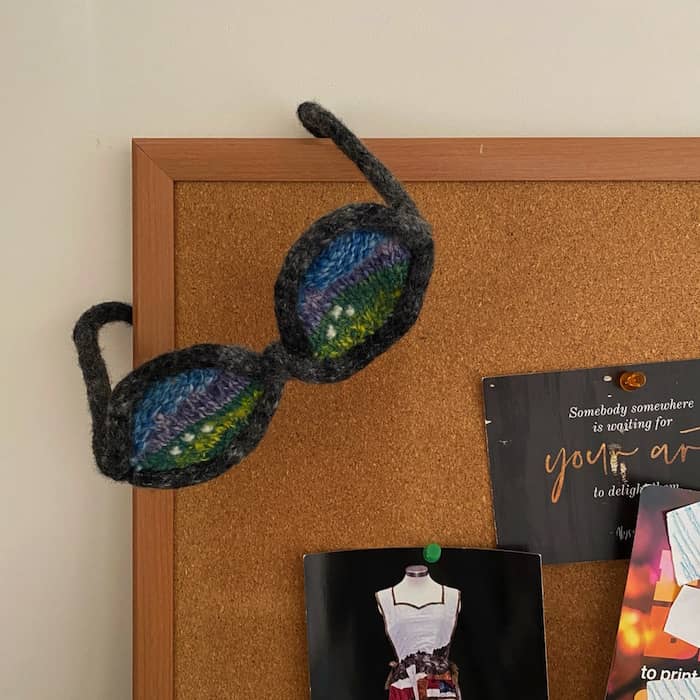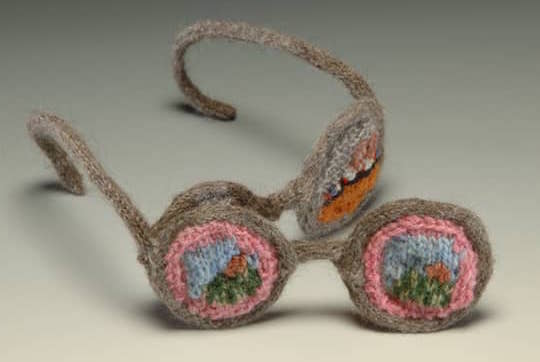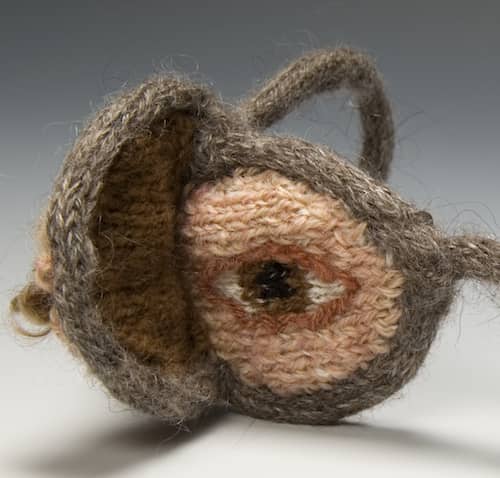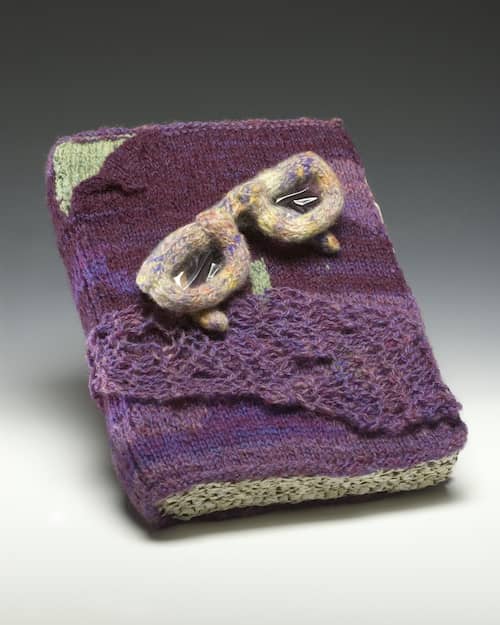I recently uncovered one of my earliest sculptures while doing some much-needed re-organizing. It’s a piece called Mountain View, the first in a series I made with eyeglasses shapes as the central design element. I made it in response to a call for entries to an exhibition whose theme was pastoral vision. I played with the meaning of the word “vision” and came up with the idea of seeing mountains through eyeglasses. At the time, I relied on prompts from exhibit calls to generate ideas for art subjects. Although the piece was not accepted into the show, it became the germ of a fruitful series of works based on eyeglasses.
That first piece is very simple and barely three-dimensional. I was just learning how to create 3D shapes by bending wire at the time. Mountain View is really just a wire frame holding flat pieces of knitting. The sheep are tiny embroidered x’s of white yarn. It made me appreciate how much I’ve developed my sculpture skills in the past 15 years.

Mountain View, handspun wool, wire, 3 x 6 x 8 inches, on my studio bulletin board. © 2002 Eve Jacobs-Carnahan.
I have worn eyeglasses since middle school, so I consider them a necessity. More than adornment, they are an integral part of my existence. By using eyeglasses in my artwork, I directly invited the viewer to see the world from my perspective. It was a way to bring the viewer right into my head. Most art tries to convey the artist’s vision; this was a fairly literal invitation to see what I see. I hope I am more subtle in my entreaties now.
Eyeglasses literally focus the world for me by transforming blurry images into clear figures, objects, and landscapes. These artworks sort of do the reverse. The pictures I stitched on the knitted lenses are blurry. The pastoral scene in Mountain View really resembles the world when I gaze at the landscape without my glasses on.
Though Rose Colored Glasses presents two views of the world: the real life view and the rosy image people often keep in their head. I made it in response to a local controversy over the expansion of a shopping center. People often move to rural areas, because they are attracted to the beauty of the farms and green forested hillsides. Once they settle in, they seek the commercial conveniences commonly found in suburban sprawl. Those were the contrasting images that I had in my head when I made that piece.

Through Rose Colored Glasses, Knitted handspun wool and mohair, wire, 3 x 6 x 10 inches. Private collection. © 2004 Eve Jacobs-Carnahan.
Eyeglasses as a symbol of understanding
I’ve also used eyeglasses to speak about seeing in a metaphorical way. Uncover and Narrow Vision both speak to uncovering truths and understanding the world beyond what we see on the surface. The peeling layers on the book in Uncover attest to the need to look deeply, beyond the surface, to understand an issue. It’s easy to take things at face value, but that may not be the whole story. These are the only glasses in the series that are not stitched. Their lenses are made of clear plastic film; clear because the wearer is doing the hard work that leads to true comprehension.
Uncover, handspun wool, paper ribbon, wire, plastic, 3 x 7 x 10 inches. Private collection. © 2005 Eve Jacobs-Carnahan, Photo by Paul Rogers, Stowe, VT
The last piece in the series is Narrow Vision. It remains relevant today in 2021 as so many people close their eyes to avoid confronting reality. Whether the blinkers are self-imposed or a product of misinformation, Narrow Vision speaks to the problem of closing oneself off from reality.

Narrow Vision, wool, mohair, wire, wood, 4 x 8 x 8 inches. $450. © 2006 Eve Jacobs-Carnahan. Available for purchase.
Looking at these works now, I am struck by how personal they are. The scale invites you to hold them in your hand. The Narrow Vision glasses appear to have been just taken off and put down on the desk. That is, if you could take out your eyeballs. The eyes are pretty realistic with the closed eyelashes, made from curly locks of mohair, adding a lively, charming touch.
I’m glad I responded to that pastoral vision exhibition call. That unsuccessful entry spawned an engaging exploration of how we see and perceive out world, as well as the work we need to do to really understand it.


Thanks for sharing this work from your past. I appreciate the explanations of what you were trying to convey too. Very powerful.
Joanne, I’m glad the explanations enhanced your view of the work. They help me see where my current work came from.
Eve, I love this series and SO enjoyed getting a bird’s eye view into how it evolved, what your thoughts and inspiration were. Lends even more meaning to the beautiful work!
Thanks so much, Christine!